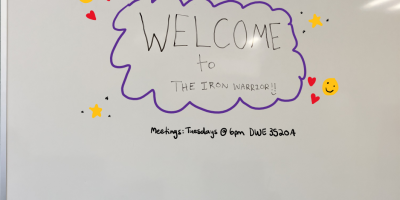It’s been an exciting two weeks at Waterloo!
Lots of stuff has happened. The draft of my team’s 4YDP report has been submitted to the technical advisor for review, the group Biomechanics paper is in, grad school acceptances are rolling in, and a very hotly campaigned referendum has run its course.
Major kudos to the Chief Returning Officer (Jennifer Coldwell), the Yes Committee (Melissa Buckley & Madeline Amszej), and the No Committee (Filzah Nasir) for inspiring so many students in the B-Society to vote! The participation rate for B-Soc was 29.7%, or 1145 students! In comparison, the voter turnout for the EngSoc B-Society elections was 18%, and the Feds Election less than 5%. Even the the voter turnout for A-Soc (Fall 2014) was 686 – and though I don’t have percentages for voter participation, one assumes from the KW housing market there are many more students on term in Fall than Winter.
This difference in voter participation can be attributed to the extremely aggressive campaigns run by both the Yes and No Committees: the Yes Committee had a head start on posters, though I think the No Committee eventually ponied up for Facebook ads. In contrast, the A-Soc referendum had neither a Yes or No Committee, and though all the candidates for the B-Society Exec positions are undoubtedly passionate about the betterment of engineering at UW, it is a little bit less exciting when most of the candidates run uncontested.
I have no idea why the Feds election turnout was so low, though. The 2015 turnout may have been 5%, but the 2014 turnout was 11%.
Anyways, as a result of the E7 referendum results, E7 will still be built with student space, but the undergraduate students will not get official naming rights to the study area. Check out the Iron Inquisition on the back cover to see what might have been, had B-Society voted Yes to the referendum.
Speaking of the paper – thanks to everyone who contributed to this issue! There was a lot of content but so far this term I haven’t had to cut any content but my own. Special shoutouts to Caitlin for her excellent coverage of the US-Iran nuclear talks (incidentally, my favourite article this issue!), and Elizabeth for her rundown of what TA strikes at UT mean for lecturers at Waterloo and beyond.
Also thanks to Nina for moral support, Hank for magically acquiring pizza, Bryan for taking care of the Iron Inquisition, and Emmanuel for supernaturally being able to write an article on Thor while taking seven courses, no electives. I’ve never taken seven courses. Actually, if one disregards my 4YDP, I’m only taking four courses right now.
And thank you to the legion of copyeditors. It gets harder and harder to keep track of you all, but I sleep well at night because I know you will make sure that all the articles end up nice and readable.
Now it’s time to move on to the meat of this editorial: on March 6th, the Ontario government published It’s Never Okay: An Action Plan to Stop Sexual Violence and Harassment. The plan has the weight of $41 million buckaroos over 3 years to support its implementation. Highlights include a multimedia campaign focussed on overcoming the bystander effect, a new sex-ed curriculum to help children learn about healthy relationships and consent, and workplace safety legislation.
On paper, these are all great things! But when reading this in greater detail, one gets an uneasy feeling.
Premier Wynne opens with the assertion that she’d like to “challenge and change the deep-rooted attitudes and behaviours that contribute to sexual violence and harassment… it is important that our young people learn about gender equality and respectful relationships from the start. We need to talk about sexual violence and harassment in every community, every classroom, and every workplace. And that conversation needs to include everyone – women and men, young people, seniors, people living with disabilities, newcomers and members of culturally diverse communities, aboriginal people, visible minorities, and the LGBTQ community.” So far, so good.
Then Tracy MacCharles, the Minister Responsible for Women’s Issues, chimes in: “I am grateful to all the courageous men and women who have survived sexual assault and shared their personal and often traumatic stories to help end the violence.”
Three sentences later, she says, “With every new report in the media, with every new indication that a woman has been sexually violated or harassed, we recognize anew that there is much to be done and a long way to go.”
Read that again: “Every new indication that a woman has been sexually violated or harassed.”
This is the part where I ask, “What about the men?”
For all its careful gender neutral wording, and Wynne’s desire to challenge social norms, It’s Never Okay betrays its deep-seated conviction that sexual violence is a crime committed by men against women. Which is true.
But I’m bombarded by stats that “one in three women will experience some form of sexual assault in her lifetime”, “in 99% of sexual assaults, the accused perpetrator is male”, and such gender-specific numbers. So women with disabilities are “three times as likely to be forced into sexual activity by use of threats or force” – how about men with disabilities? Or people with disabilities, period? And “in three-quarters of sexual assaults, the woman knows her attacker” – is this true for men too, or just women?
The authors of this report are perfectly capable of producing some gender neutral statistics: “28% of Canadians say they have been on the receiving end of unwelcome sexual advances, requests for sexual favours, or sexually-charged talk while on the job.” In fact, the whole section on workplace sexual harassment is strong in spite of (or because of?) its gender neutrality.
But if you say you want “women and girls, [and] men and boys to know who to call and where to turn if they (or someone they love) experience sexual violence,” you’d better not spend 90% of the report crying out about how men should be careful not to assault women, and that if they can’t tell that assault is bad, then there exist community support groups for that kind of thing. Women apparently have no need for such groups. The report says that “it is crucial that we leave behind damaging ideas about sex and gender” but fails to address sexual assault on males, or by females, as anything other than an abstract idea.
Have you ever heard of small dog syndrome? Imagine, if you will, taking a chihuahua and a rottweiler on a walk. You encounter a jogger and the rottweiler takes a run at the jogger. It tips the scale at 100 lb, so you hold it back and seriously consider remedial obedience classes. Then the chihuahua scrambles up and humps the jogger’s leg. This is considered cute because the chihuahua is 5 lb and can’t possibly do any harm, and thus was never trained not to jump up on people.
Do you understand my metaphor yet? If not, watch the Korean movie My Sassy Girl (2001) but imagine that the protagonist is a woman who meets a man. And that the man punches her and tells her to drop dead. This is briefly covered in my movie column on page 12 – check out its movie poster and imagine it’s a man putting a screaming woman in a headlock, instead of vice versa.
So instead of going the gender-neutral route, the authors have chosen to sensationalize sexual assault as exclusively man-against-woman through the report’s tone and choice of examples, which does nothing to expand one’s paradigm. Any schmuck, when asked about sexual assault, can conjure up a vague image of a man attacking a woman, and the report doesn’t need to help them strengthen that conceptualization of sexual assault. The problem is that your average Joe, Delilah, and Harry won’t even consider the case of a woman attacking a woman, a man attacking a man, or a woman attacking a man.
I can’t deny that most violence is against women, and perpetuated by men. But there are examples within the report itself that show that it’s not that hard to write gender-neutral text and use gender-neutral statistics! Alternately the authors could have included statistics about violence on men, or committed by members of the population who are not cissexual men. Neither of these would have weakened the message that sexual assault is harmful and that social norms and mores must change before widespread sexual violence and harassment become a thing of the past
I am very disappointed.
Let’s hope for better news next week.
Until next issue —
Nancy Hui
Letter from the Editor: Fighting hypocrisy and degendering sexual violence in It’s Never Okay
Note: This article is hosted here for archival purposes only. It does not necessarily represent the values of the Iron Warrior or Waterloo Engineering Society in the present day.




Leave a Reply